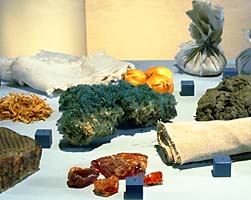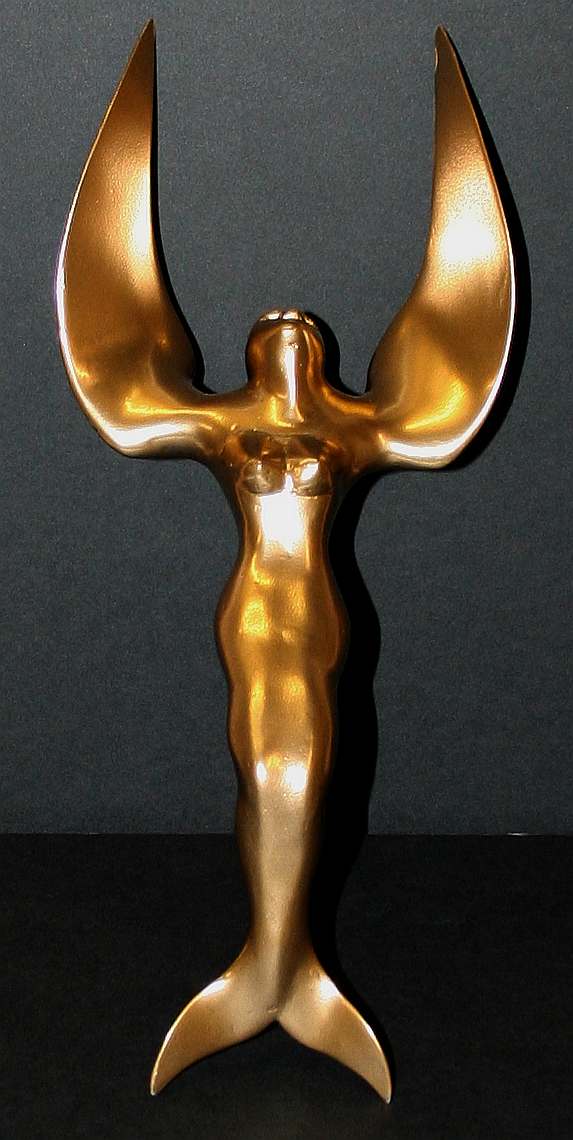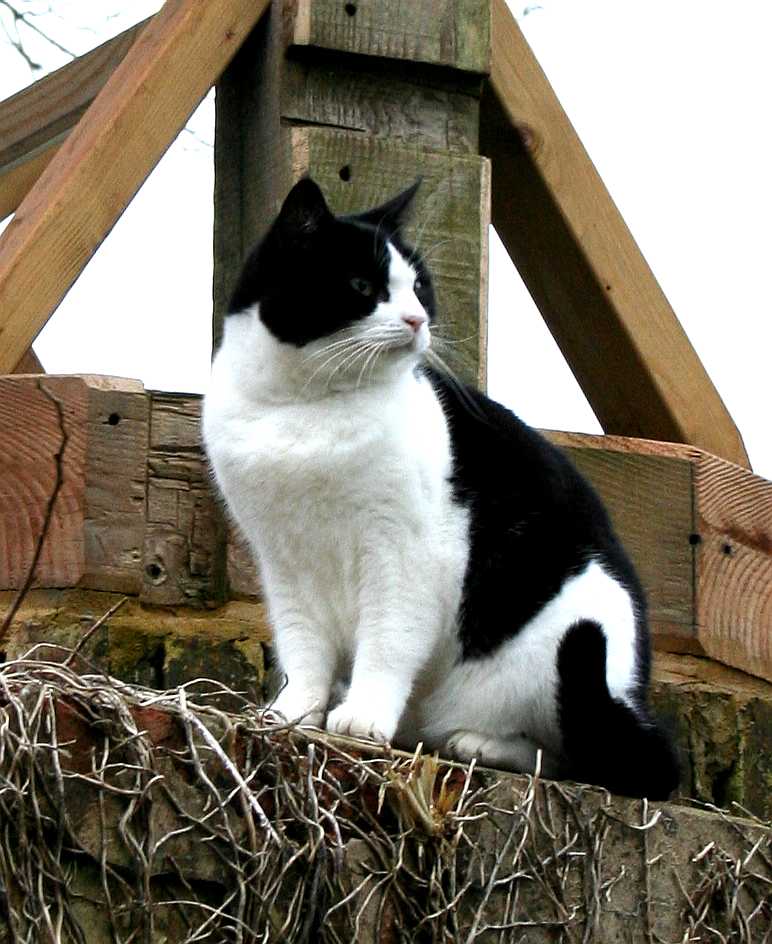Animal
worship in ancient Egypt is part of the culture of daily life
of Egyptians. Animals of every kind were respected and
revered, as they were in close contact with deities and gods
that the average Egyptian could not reach.
The
cat in ancient Egypt, or miw (to see), was a
sacred and respected beast.
These
small companions fascinated the Egyptians, and were venerated
by all. It was in Egypt that the cat was first domesticated
4,000 years ago and where they were held in the most
admiration and respect. There is evidence of wild felines
around the banks of Egypt, but it was not until around 2000 BC that the fully domesticated cat was brought into the
houses of Egyptians.
The
first domesticated Egyptian cats in Egypt were more than
likely used for warding off the common asp and other snakes,
and the typical chasers of rodents. Slowly though, the cat
became more to the Egyptians than just a normal animal, the
cat became a god.

CATS LED PRIVILEGED LIVES
Diodorus briefly reiterates the much earlier comments of
Herodotus about the devotion and great veneration afforded
cats not only during their lifetimes, but even after death.
Society was so devout, that if someone intentionally or
unintentionally killed a cat, he was put to death. Even in
cases of critical national famine, sacred animals such as the
cat apparently went unscathed. In addition to being sacred,
Diodorus notes their useful characteristics, such as
confronting asps positioned to bite and warding off other
snakes. Cats were also of service to fowlers in their search
for birds in the Nile marshes, as attested by a wall painting
in the New Kingdom tomb of Nebamun at Thebes. Diodorus
explains that a portion of land for sacred cats was
consecrated, which provided for their upkeep and made them
self-supporting.
As felines of privilege within the temple of Bubastis
precincts, they lived as the earthly embodiment of the temple
goddess Bastet. Mummies were placed in the cult center and
dedicated to Bastet in order to increase her favor. Evidence
also suggests that numerous domesticated cats were bred and
some deliberately killed in order to be mummified. This was
done to satisfy the great demand for them by zealous pilgrims,
who bought and dedicated them at cult centers. Many were
needed to go around. Herodotus relates the excitement
generated among the throngs of pilgrims after they arrived at
Bubastis:
"...they make a festival and great sacrifices,
and more wine is drunk at this feast than in the whole year
beside."
(Note 7) The number attending the festival may
have reached the extraordinary level of some 700,000 people.
It may be that cat mummies numbered in the millions, were it
possible to tabulate those buried in sites all over Egypt. As
eternal life was all to the ancient Egyptians, so too was it
for their sacred animals. The life of a cat in the hereafter,
therefore, was a place of sweet greenery, mice, and tasty
morsels. There, "meows" would be heard in abundance.

During
the New Kingdom (1540 to 1069 BC), there were many tomb scenes
that started showing cats as part of everyday life. The
ancient Egyptians took their cats on hunting excursions
instead of dogs, The most popular excursions being the marshes
where cats may have been trained to retrieve fowl and fish.
Another very common scene in tomb paintings was the picturing
of a cat seated underneath a woman's chair. Children had
become known in their family as Mit or Miut, showing great
affection not only for the child but for the cat as well.
Statues of cats were placed outside the house to protect the
inhabitants and to ward off evil spirits. This showed
scientists that the cat had become an integral part of the
ancient Egyptian family life.
Mafdet
was the first Egyptian feline deity, sometimes depicted as a
lynx, but the most famous cat goddesses in the world, first
revered by the ancient Egyptians were Bastet (also known as
Bast, Pasch, Ubasti) and the lion-headed Sekhmet.
Bastet
had the roles of fertility, protector of children and the
protector of all cats. Bastet became so popular infact that
she became a household goddess. This goddess was called Bastet
when in full cat form, and Bast when only having the head of
one and the body of a beautiful woman. Bastet's counterpart
was the goddess Sekhmet who represented the cat goddess'
destructive force. Sekhmet is known as the goddess of war and
pestilence. Together, Bastet and Sekhmet represented the
balance of the forces of nature in Egypt.
In
Bubastis, or Tell Basta, the cats lived a lavish life as the
`embodiment' of Bastet in her temples. Here they were served
upon and taken care of until they passed away, and it was here
that their bodies were mummified and given as offerings to
Bastet. Bubastis contains the remains of over 300,000 cat
mummies. Upon being inspected, some feline mummies had severe
trauma to the head or neck, signifying that they were killed
on purpose, perhaps to lower the growing population or for
offerings for Bastet. Giza, Abydos, and Dendereh were also
feline tomb cities other than Bubastis.

Mummified
cat Amsterdam Museum
When
a cat died their former owners and occupants of the house
would go into deep mourning and shave their eyebrows as a sign
of grief. The process of feline
mummification had six steps:
-
Removal
of organs
-
Body
is stuffed with sand or packing material
-
Feline
is placed in a sitting position
-
Body
is wrapped tightly
-
Faces
and designs are painted on wrappings with black ink
-
No
chemicals, only natural dehydration
In
the tombs of the cats were set bowls of milk along with mice
and rats.
Cats
were not only protected by almost every occupant of Egypt, but
also by the law. So extreme was the devoutness of the
Egyptian culture to the cat, that if a human killed a feline,
either intentionally or unintentionally, that human was
sentenced to death. Laws were set that also forbid the
exportation of cats, though more often than not, many were
smuggled to the neighboring Mediterranean countries. Documents
state that armies sometimes were set out to recapture these
cats from the foreign lands.
Herodotus
stated a story once about a fire in a house in Egypt. The men
from the house stood outside in a line to protect the cats
from harm and danger. Another statement from Herodotus
explains even greater the significance of the cat to Egypt.
Herodotus begins with the Egyptians in war with Persia. The
Persian general had decided to collect as many cats that his
men could find or steal, knowing the great importance of the
cat to Egypt. The soldiers then returned to the town of
Pelusium and set the cats free on the battlefield. Horrified,
the Egyptians surrendered the city to the Persians rather than
harm the cats.
MUMMIFICATION METHODS
The technical processes of mummification are incompletely
known, as the ancient Egyptians did not record them, neither
for humans nor for sacred animals. For clues we must look to
modern scientific investigators and to ancient writers. The
Greek historian and geographer Strabo (64/3 BC-AD 21) makes a
scant comment about workshops in a suburb of Alexandria,
"...there are many gardens and graves and halting-places
fitted up for the embalming of corpses...." (Note 2)
Still, it is unknown whether animals were mummified in the
same "halting-places" or workshops as humans. But
the process appears to have similarities.
The words of
Herodotus and Greek historian Diodorus Siculus (?-ca. 21? BC)
shed a faint light, albeit brief. Herodotus mentions
"Dead cats are taken away into sacred buildings, where
they are embalmed and buried, in the town of Bubastis...."
(Note 3) Diodorus records, with little exactness, that when a
cat died, it was wrapped in fine linen and taken to be
embalmed. He adds, "...after it has been treated with
cedar oil and such spices as have the quality of imparting a
pleasant odour and of preserving the body for a long time,
they lay it away in a consecrated tomb." (Note 4) There
is archaeological evidence at Bubastis that cat bodies had
been burnt in brick furnaces and therefore not embalmed as was
the rule at other sites. But this idea is still in debate.
The art of mummification was
perfected in the Third
Intermediate Period (1070-712 B.C.). Around 450 B.C. (Late
Period), the Greek historian Herodotus
documented the process:
As much of the brain as it is possible is extracted
through the nostrils with an iron hook, and what the hook
cannot reach is dissolved with drugs. Next, the flank is
slit open . . . and the entire contents of the abdomen
removed. The cavity is then thoroughly cleansed and washed
out . . . Then it is filled with pure crushed myrrh, cassia,
and all other aromatic substances, except frankincense. [The
incision] is sewn up, and then the body is placed in natron,
covered entirely for 70 days, never longer. When this period
. . . is ended, the body is washed and then wrapped from the
head to the feet in linen which has been cut into strips and
smeared on the underside with gum which is commonly used by
the Egyptians in the place of glue.
Bob Brier, Egyptian Mummies
Natron, a disinfectant and
desiccating agent, was the main ingredient used in the
mummification process. A compound of sodium carbonate and
sodium bicarbonate (salt and baking soda), natron
essentially dried out the corpse. Obtained from dried-up river
beds, it was packed around and inside the body in linen bags,
and left for 35 to 40 days to draw moisture out of the
tissues. By removing the organs and packing the internal
cavity with dry natron, the body tissues were preserved.
The
body was filled with Nile mud, sawdust, lichen and cloth
scraps to make it more flexible. Small cooking onions or linen
pads were sometimes used to replace the eyes. Beginning in the
third dynasty, the internal organs (lungs, stomach, liver and
intestines) were removed, washed with palm wine and spices,
and stored in four separate canopic jars made of limestone,
calcite or clay. Prior to this, the abdominal contents were
removed, wrapped and buried in the floor of the tomb. However,
the heart was left in the body because it was considered the
centre of intelligence.
|

|

|
|
Materials
used in mummification:
-
linen
-
sawdust
-
lichen
-
beeswax
-
resin
-
natron
-
onion
-
Nile mud
-
linen pads
-
frankincense
|
Mummification
tools:
Brain hooks
(replicas based on examples from the Rijksmuseum,
Leiden)
Oil jar
(Royal Ontario Museum 948.1.17)
Funnel
(replica)
Embalmer's
knife
(Smithsonian Institution 221.389)
|
The corpse was then washed,
wrapped
in linen (as many as 35 layers) and soaked
in resins and oils. This gave the skin a blackened
appearance resembling pitch. The term
"mummification" comes from the Arabic word mummiya,
which mean bitumen, a pitch substance that was first used in
the preservation process during the Late
Period. The family of the deceased supplied the burial
linen, which was made from old bed sheets or used clothing.
Nevertheless, a dim scene emerges to suggest some
activities of embalming. As with craft centers, the
preparation quarters were busy, such as those seen depicted in
wall paintings showing industrious artisans in workshops for
furniture, jewelry, pottery, and stone objects. Thus,
brown-skinned embalmer priests can be imagined as they
devotedly bend over their tasks, or carry out other duties.
Metal and stone tools essential to the preparation of the
carcass and dehydrating substances are at hand. They might
embalm the cats simply by softening them in natron (mostly
sodium carbonate and sodium bicarbonate), making no attempts
to otherwise preserve the body, or sometimes bury or perhaps
burn them, and later retrieve the resultant skeletons to be
carefully wrapped in linen. In a nearby area would be pots of
bitumen that shape and support the linen-wrapped remains and
wood boxes filled with fine white linen from a local textile
workshop.
It was important that outwardly the mummy's head
should resemble a living cat. Relief models, sculpted heads,
statues, and miniature coffins might be placed around the
workshop for use as models for proportion and form, painting
facial details or decorations on the linen, or for numerous
pottery, wood, or bronze coffins for the mummies. Funerary
priests dressed in white linen garments were there to oversee
the work and recite prayers over a finished mummy or groups of
them. Such workshop activities were likely to be separated
according to rank.
The
cat held a powerful spot in the history of Egypt. While she
protected his land and his people, she also protected the
mystique that is and was the cat in ancient Egypt.
"Animal
mummies are very, very important because we can learn not only
about the ancient environment - many of these animals are now
extinct in Egypt - but also about Ancient Egyptians'
beliefs," said Salima Ikram, co-director of the Animal
Mummy Project and the driving force behind the
"adopt-a-mummy" concept.
"Pet
mummies are particularly nice because you get an idea of
Ancient Egyptians' love for their animals," she added.
The ancient Egyptians made mummies of their favourite pets,
including dogs, cats, monkeys and gazelles to take the animals
with them into the afterlife. They
also offered mummified animals as offerings to particular
gods. "People used to purchase animal mummies made
by priests as prayers - like lighting candles in a
church," says Dr Ikram.
"If you wanted to be lucky in love, you made a cat
mummy offering to Bastet, the cat goddess of love."
But X-rays have revealed some of the mummies to be ancient
fakes, containing only rags or pieces of animal, which Dr
Ikram says were "probably sold to unsuspecting
pilgrims."
A recently acquired mask from a cat mummy (Figure 1)
reflects many aspects regarding the extraordinary religious
beliefs and customs involving sacred animals in ancient Egypt.

MASK FROM A CAT
MUMMY
Roman Period, 1st Century AD.
Ref. McClung Museum: Gift of Dr. and Mrs. Galal El-Sayad,
Fig1
In such a setting, the McClung Museum's small, stiff mask
(6.7 cm. high x 5.7 cm. wide; ears 2.21 cm. high.), of unknown
provenance, was naturalistically modeled in linen and bitumen
(pitch). The linen was smoothed and formed over soft bitumen,
the latter acting like pliable clay when guided by fingers of
an artistic embalmer. On the exterior, an application of
several layers of the once-bright, white, finely woven linen
resulted in a slightly bumpy surface (Figure 2).

CAT MUMMY
MASK PROFILE Fig 2
Facial features are detailed in line by black paint. (Note
5) Encircling the short neck is a dark stain with vestiges of
bitumen where the neck had extended into the former upper body
wrappings. Tiny sand particles rest on the left side of the
upper head, side of the face, around the right eye, and
between the linen weave throughout areas on the top and rear
of the head, which create an illusion of white patches in the
now aged, tan linen. On the interior, layers of more coarsely
woven linen are shaped over bitumen. The slightly hollowed
muzzle area is blackened by traces of bitumen[?], as is the
upper rear of the head. There are no hollows for the ears, a
separate exterior shaping method being used for them.
Almost all Egyptian gods were associated with some animal
and assumed the form of that particular beast. Although
certain species of cats are known to have lived in the wild in
prehistoric Egypt, there is no evidence that they were
worshipped. However, the tame and friendly cat reflected by
the McClung Museum's acquisition appeared in a much later
period and was revered. Not all cats were deities, even though
the species was believed sacred. A cat became sacred only
after special rituals were performed, and in the belief that
the cat deity Bastet dwelt within the animal, and perhaps by
certain markings deemed divine.
No longer just curiosities to be ignored, mummified cats
and other animal mummies have risen in importance. Research is
being conducted to document and catalog various aspects of
these creatures that are so identified with ancient Egypt. Cat
mummies are being carefully investigated in terms of religion,
cultural history, relation to the environment, questions
relating to the genus and species, whether they were wild or
domesticated, the diseases they had, and how exactly they were
mummified. Also being determined are their types; that is,
whether they were sacred, used as funerary food or votive
offerings, or were just beloved pets. The Cairo Museum, in
conjunction with the Department of Egyptology at the American
University in Cairo, leads with its important Animal Mummy
Project.
The family of cats (Felidae) is separated into two
subfamilies: the larger and the smaller. The first consists of
large wild species, such as the lion and leopard, tiger and
cheetah. The second, a small African wild cat (Felis
silvestris libyca), also named the Egyptian, or Kaffir,
cat, is the one this article concerns. This species may
actually be the ancestor of the modern domestic cat (Felis
silvestris familiaris). The exact location of the first
domesticated cat is unknown, but it may be Egypt or the Near
East, no doubt spreading from trade routes to different parts
of the world. In any case, evidence so far for the
domesticated animal in Egypt does not date before the Middle
Kingdom, circa 2000 BC, when we learn of them from tomb
paintings and cat mummies produced at that time. By the early
New Kingdom, circa 1500 BC, more representations are found in
wall paintings and reliefs. In the Late Dynastic Period, a
highpoint is reached in the appreciation of the domestic cat,
and ancient authors, such as the Greek historian Herodotus
(484?-425? BC) noted their importance. Images were being
produced on papyri, as bronze and wood figurines, on sherds,
as amulets in various materials, and in quantities as mummies.
Such representations had special magical properties and
communicated religious beliefs.
Usually, animal cemeteries are reserved for one kind of
animal. Those for cats date to around 900 BC, particularly at
Bubastis ("House of Bastet"), the temple and cult
center of Bastet. According to Herodotus, "Other temples
are greater and more costly, but none pleasanter to the eye
than this." (Note 1) The site of extensive ruins and
cemeteries, Bubastis is southeast of the modern, southeastern
Delta town of Zagazig. Situated on the mound of Tell Basta,
Bubastis may have been the capital of the entire country
during dynasties XXII-XXIII, when it reached great heights as
a major center. Cat cemeteries include those at Saqqara and
Dra Abu el-Nagga at Thebes, as well as those of lesser scale,
such as at Abydos, Dendera, and the Dakhla Oasis. Mummies were
abundantly produced in the Ptolemaic Period, circa 332-30 BC,
but even in greater numbers into the Roman Period.

CAT
HISTORY | CAT
GODDESSES | CAT
MUMMIES | CAT
WOMAN | CAT
LINKS









